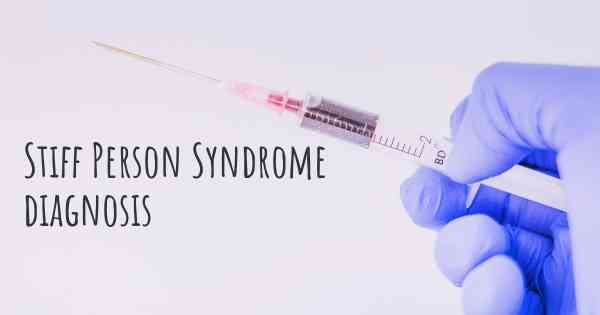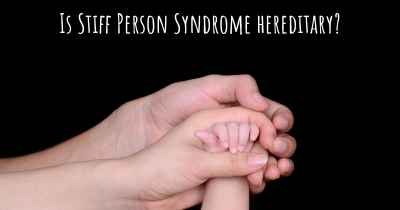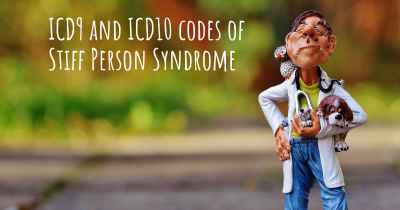How is Stiff Person Syndrome diagnosed?
See how Stiff Person Syndrome is diagnosed. Which specialists are essential to meet, what tests are needed and other useful information for the diagnosis of Stiff Person Syndrome

Diagnosis of Stiff Person Syndrome
Stiff Person Syndrome (SPS) is a rare neurological disorder characterized by muscle stiffness and spasms. Diagnosing SPS can be challenging due to its rarity and the similarity of symptoms to other conditions. However, a combination of clinical evaluation, laboratory tests, and imaging studies can help in the diagnosis of SPS.
Clinical Evaluation
The first step in diagnosing SPS involves a thorough clinical evaluation by a healthcare professional, typically a neurologist. The doctor will review the patient's medical history and conduct a physical examination to assess the presence and severity of symptoms. The key feature of SPS is muscle stiffness, especially in the axial muscles (back and abdomen), which can lead to an abnormal posture. The doctor will also look for muscle spasms, hyperreflexia (exaggerated reflexes), and other neurological abnormalities.
Laboratory Tests
Several laboratory tests can aid in the diagnosis of SPS:
- Anti-GAD Antibody Test: The majority of individuals with SPS have elevated levels of anti-glutamic acid decarboxylase (GAD) antibodies in their blood. This test measures the presence of these antibodies, which are believed to play a role in the development of SPS. However, it is important to note that not all individuals with SPS have detectable anti-GAD antibodies, and some individuals without SPS may have these antibodies as well.
- Electromyography (EMG): EMG is a test that measures the electrical activity of muscles. In SPS, EMG can reveal continuous motor unit activity even at rest, known as "continuous motor unit activity at rest" (CMAR). This finding is characteristic of SPS and can help differentiate it from other conditions.
- Blood Tests: Additional blood tests may be performed to rule out other conditions that can present with similar symptoms, such as autoimmune disorders or metabolic abnormalities.
Imaging Studies
Imaging studies are not typically necessary for diagnosing SPS, but they can be helpful in ruling out other conditions or identifying specific abnormalities. Magnetic resonance imaging (MRI) of the brain and spine may be performed to assess for structural abnormalities or signs of inflammation. However, these imaging findings are usually normal in individuals with SPS.
Differential Diagnosis
SPS can be mistaken for other conditions due to the similarity of symptoms. The following conditions should be considered in the differential diagnosis:
- Stiff-Limb Syndrome: This condition resembles SPS but primarily affects the limbs rather than the axial muscles.
- Multiple Sclerosis (MS): MS can cause muscle stiffness and spasms, but it is typically associated with other neurological symptoms and has distinct imaging findings.
- Peripheral Neuropathy: Certain types of peripheral neuropathy can present with muscle stiffness and spasms.
- Psychogenic Stiffness: Psychological factors can sometimes manifest as muscle stiffness, but careful evaluation can help differentiate it from SPS.
Conclusion
Diagnosing Stiff Person Syndrome requires a comprehensive approach that combines clinical evaluation, laboratory tests, and imaging studies. The presence of muscle stiffness, spasms, and hyperreflexia, along with elevated anti-GAD antibodies and characteristic EMG findings, can support the diagnosis of SPS. However, it is crucial to rule out other conditions that can mimic SPS. If you suspect you or someone you know may have SPS, it is important to consult with a healthcare professional for an accurate diagnosis and appropriate management.
Symptoms.
GAD levels.
Posted Feb 28, 2017 by Loretta 1000
A useful port of call is to join a support group as most are able to answer questions posed, and give caring support.
Posted Mar 1, 2017 by Liz 1000
It is usually diagnosed by a neurologist.
My experience, I was referred to a neurologist by an orthopedic surgeon after years of being treated for muscle stiffness and rigidity. She was able to diagnose me based on a neurological exam, the way I walked and my posture. She prescribed me with a very low dose of Valium while she ordered blood tests, specifically an anti-gad 65 blood test and a paraneoplastic and ANA panel. When the tests came back she scheduled an eeg. She ran tests to rule out other diseases before finally diagnosing me with Stiff Person Syndrome.
Posted Mar 2, 2017 by Michelle 1500
Posted Mar 4, 2017 by Jasmine Nardone-Franco 1430
Posted Dec 24, 2021 by Pathdoc 2500
Posted Sep 18, 2017 by Fernando Vela Vallejo 3250








